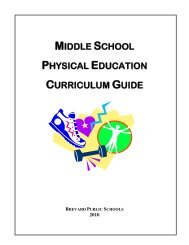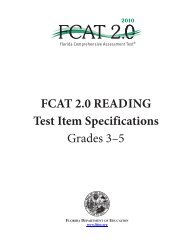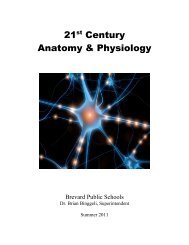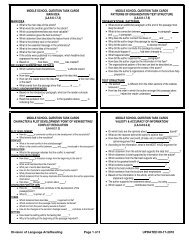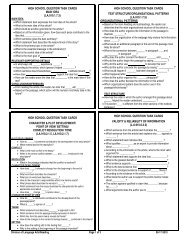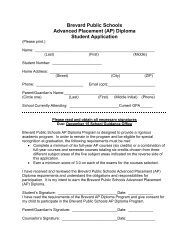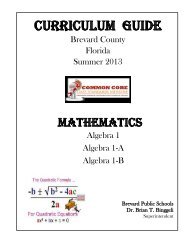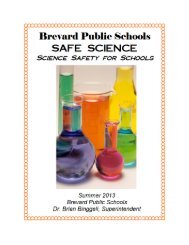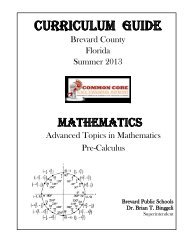High School Social Studies - Secondary Programs - Brevard Public ...
High School Social Studies - Secondary Programs - Brevard Public ...
High School Social Studies - Secondary Programs - Brevard Public ...
You also want an ePaper? Increase the reach of your titles
YUMPU automatically turns print PDFs into web optimized ePapers that Google loves.
18<br />
Unit 3: Islam, Africa, Southeast Asia.<br />
Chapters 10, 11 and 12 (15 days)<br />
Essential Vocabulary<br />
• Who was Mohammed and when and where<br />
did he live<br />
• What is the purpose of a Mosque<br />
• What is a sect, and what distinguishes<br />
Sunni from Shiite Muslims<br />
• Where is Mecca and what is its<br />
significance<br />
• What is the Koran<br />
• What is a theocracy<br />
• What is the Caliphate<br />
• Who were Huran al Rashed and Ibn<br />
Khaldun<br />
• Who were the Muhgals<br />
• What is a Sultan and where was the<br />
Mughal Sultanate<br />
• Who were the Ottomans<br />
• Who was Suleyman and what was his role<br />
in the Ottoman Empire<br />
• Who were the Safavids<br />
• Who were the Bantus<br />
• What is a commodity and which ones are<br />
found in Africa<br />
• What was Ghana and where was it<br />
• What was Mali and where was it<br />
• Who was Mansa Musa and why was he<br />
significant<br />
• What was the Songhai and where was it<br />
• What is Swahili<br />
• What is a lineage<br />
• Who were the Tang and the Song<br />
• Who was Genghis Khan and what was his<br />
significance in history<br />
• Who was Marco Polo and what was his<br />
significance to the diffusion of culture<br />
• What were the characteristics of the Ming<br />
Dynasty<br />
• Describe feudal Japan<br />
• Who were the samurai and what was their<br />
role in Japan<br />
• What was the Shogun and what was a<br />
significant Shogunate in feudal Japan<br />
Potential Activities<br />
• Have students create news teams and pick a<br />
chapter to create a news broadcast.<br />
• Have students pick a person of interest<br />
from the chapter and create a journal for<br />
that person. (i.e. Mansa Musa or Marco<br />
Polo).<br />
• Have students create a chart of the<br />
civilizations of North Africa.<br />
• In test prep book, documents are available<br />
with questions on pages 34 to 40 and 46 to<br />
53.<br />
Alternative Assessment<br />
• DBQ's are available from the DBQ project<br />
on Mansa Musa (WH Minis, volume 2).<br />
• Students can create visual timelines on a<br />
poster of significant events.<br />
• There are any compare and contrast<br />
opportunities. These can be done as a chart,<br />
Venn Diagram, or essay:<br />
Shiite v. Sunni<br />
Ottoman v. Safavid<br />
Islam V. Christianity & Judaism (FSSS)<br />
Formative Assessment<br />
• Have students write quiz questions or<br />
bellringers for the next day to turn in at the<br />
end of class.<br />
• Have students generate crosswords.<br />
Notes<br />
Chapter 11: can be taught relatively quickly as a whole unit.<br />
Chapter 12: focus on sections 1 through 4



